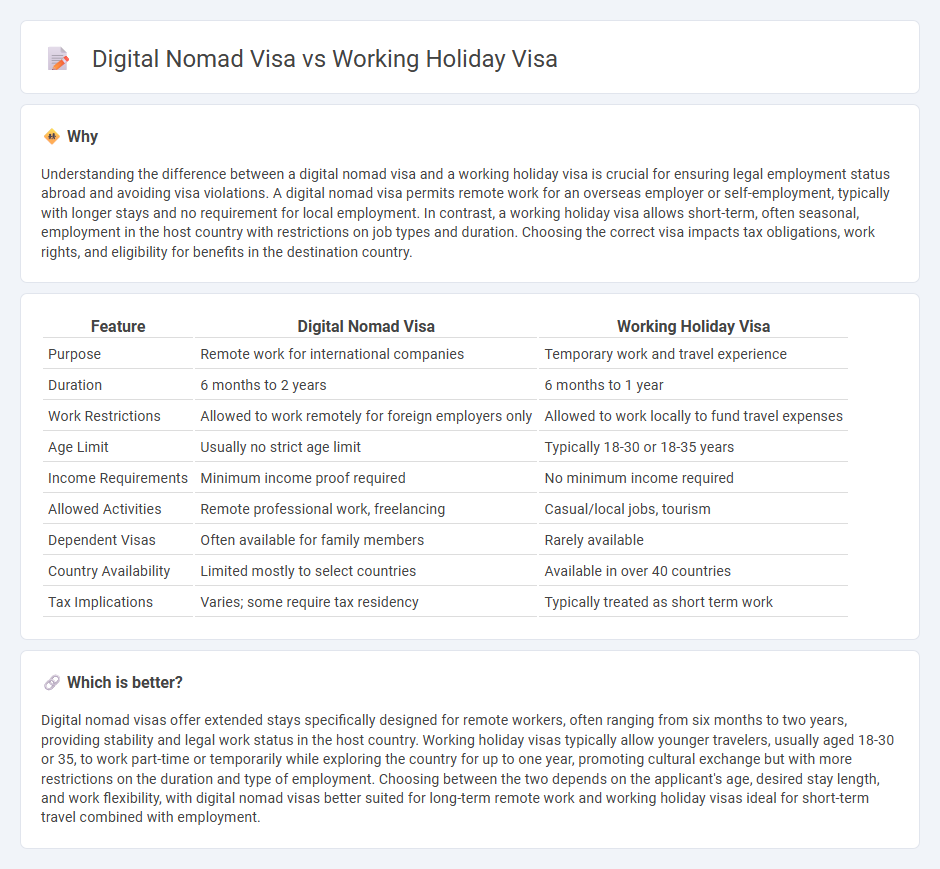
Digital nomad visas enable remote professionals to legally live and work in foreign countries for extended periods, typically ranging from six months to two years, without local employment restrictions. Working holiday visas target younger individuals, usually aged 18-30, allowing temporary residence combined with short-term employment to support travel expenses. Explore in-depth comparisons to determine the ideal visa for your international work and travel ambitions.
Why it is important
Understanding the difference between a digital nomad visa and a working holiday visa is crucial for ensuring legal employment status abroad and avoiding visa violations. A digital nomad visa permits remote work for an overseas employer or self-employment, typically with longer stays and no requirement for local employment. In contrast, a working holiday visa allows short-term, often seasonal, employment in the host country with restrictions on job types and duration. Choosing the correct visa impacts tax obligations, work rights, and eligibility for benefits in the destination country.
Comparison Table
| Feature | Digital Nomad Visa | Working Holiday Visa |
|---|---|---|
| Purpose | Remote work for international companies | Temporary work and travel experience |
| Duration | 6 months to 2 years | 6 months to 1 year |
| Work Restrictions | Allowed to work remotely for foreign employers only | Allowed to work locally to fund travel expenses |
| Age Limit | Usually no strict age limit | Typically 18-30 or 18-35 years |
| Income Requirements | Minimum income proof required | No minimum income required |
| Allowed Activities | Remote professional work, freelancing | Casual/local jobs, tourism |
| Dependent Visas | Often available for family members | Rarely available |
| Country Availability | Limited mostly to select countries | Available in over 40 countries |
| Tax Implications | Varies; some require tax residency | Typically treated as short term work |
Which is better?
Digital nomad visas offer extended stays specifically designed for remote workers, often ranging from six months to two years, providing stability and legal work status in the host country. Working holiday visas typically allow younger travelers, usually aged 18-30 or 35, to work part-time or temporarily while exploring the country for up to one year, promoting cultural exchange but with more restrictions on the duration and type of employment. Choosing between the two depends on the applicant's age, desired stay length, and work flexibility, with digital nomad visas better suited for long-term remote work and working holiday visas ideal for short-term travel combined with employment.
Connection
Digital nomad visas and working holiday visas both facilitate international employment by allowing individuals to live and work abroad temporarily, promoting cross-cultural exchange and economic contribution. While digital nomad visas cater primarily to remote workers with stable internet-dependent jobs, working holiday visas target younger travelers seeking flexible employment and immersive experiences in host countries. These visa types collectively enhance global labor mobility, enabling a diverse workforce to engage in international markets without traditional work permit barriers.
Key Terms
Duration of Stay
The Working Holiday Visa typically offers a stay duration of 6 to 12 months, allowing participants to travel and work in a foreign country while experiencing its culture. In contrast, the Digital Nomad Visa extends the stay from 1 to 2 years or more, catering specifically to remote workers seeking long-term residence without local employment restrictions. Explore detailed comparisons between these visas to decide which duration aligns best with your international work and travel plans.
Work Restrictions
Work restrictions on a working holiday visa typically limit visa holders to short-term employment with specific employer types or capped hours to encourage cultural exchange rather than long-term career development. Digital nomad visas often impose fewer work restrictions, allowing holders to work remotely for foreign companies without local labor market constraints, targeting location-independent professionals. Explore detailed comparisons to understand which visa aligns best with your career goals and travel plans.
Remote Work Eligibility
Remote work eligibility for a working holiday visa often depends on the country's specific regulations, typically allowing short-term employment but may restrict long-term remote work for foreign employers. Digital nomad visas are explicitly designed to accommodate remote workers, granting legal residency for extended periods while working remotely for companies outside the host country. Explore the differences in visa terms and benefits to determine which option fits your remote work lifestyle better.
Source and External Links
The Ultimate Guide to Working Holiday Visas for US Citizens in 2025 - Working holiday visas allow young adults, usually aged 18 to 30, to live, travel, and work in certain countries like Australia, Canada, Ireland, New Zealand, Singapore, and South Korea for typically 12 months without needing traditional job sponsorship.
Working holiday visa - Wikipedia - A working holiday visa is a residence permit letting travelers work and sometimes study abroad to fund travel, usually under reciprocal agreements encouraging cultural exchange, with age limits and work restrictions usually imposed.
Your Guide to Working Holiday Visas for U.S. Citizens | GoAbroad.com - Requirements vary by country, for example, Australia's working holiday visa requires applicants to prove sufficient funds (AU $5,000 minimum) and limits work with one employer to six months, while Ireland requires applicants to be full-time students or recent graduates and proof of financial means.
 dowidth.com
dowidth.com